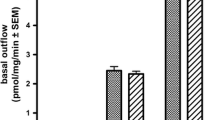Abstract
The systemic injection of kainic acid (KA) has been shown to destroy neurons in the hippocampus and to induce limbic-type seizure activity. However, little is known on the neurochemical events that are associated with this convulsant effect. In the present work we studied the spontaneous and the K+-stimulated release of labeled τ-aminobutyric acid (GABA), glutamate, serotonin and dopamine, in hippocampal slices of KA-treated rats, at the moment of clinical seizures (2 h) and 72 h later. At the onset of convulsions we found a 40–45% decrease in the K+-stimulated release of GABA. The release of the other neurotransmitters was not significantly affected by KA treatment. After 72 h GABA release was still reduced by 30–40%. It is concluded that the epileptogenic effect of KA in the hippocampus is probably related to a diminished inhibitory GABAergic neurotransmission.
Similar content being viewed by others
References
Ben-Ari, Y. 1985. Limbic seizure and brain damage produced by kainic acid: mechanisms and relevance to human temporal lobe epilepsy. Neuroscience 14:375–403.
Ben-Ari, Y., Tremblay, E., Riche, D., Ghilini, G., and Naquet, R. 1981. Electrographic, clinical and pathological alterations following systemic administration of kainic acid, bicuculline or pentetrazole: metabolic mapping using the deoxyglucose method with special reference to the pathology of epilepsy. Neuroscience 6:1361–1391.
Nicoletti, F., Perciavalle, V., Berretta, S., Speciale, C., Polizzi, M., Patti, F., De Simone, D., Sortino, M. A., Di Giorgio, R. M., and Scapagnini, U. 1984. Altered time course of changes in the hippocampal concentration of excitatory and inhibitory amino acids during kainate-induced epilepsy. Eur. J. Pharmacol. 103:133–137.
Sperk, G., Lassmann, H., Baran, H., Kish, S. J., Seitelberger, F., and Hornykiewicz, O. 1983. Kainic acid induced seizures: neurochemical and histopathological changes. Neuroscience 10:1301–1315.
Sperk, G., Lassmann, H., Baran, H., Seitelberger, F., and Hornykiewicz, O. 1985. Kainic acid-induced seizures: dose-relationship of behavioural, neurochemical and histopathological changes. Brain Res. 338:289–295.
Walaas, I. 1983. The hippocampus. Pages 337–358,in Emson P.C. (ed.) Chemical Neuroanatomy, Raven Press, New York.
Sloviter, R. S. and Damiano, B. P. 1981. On the relationship between kainic acid-induced epileptiform activity and hippocampal neuronal damage. Neuropharmacology 20:1003–1011.
López-Colomé, A. M., Tapia, R., Salceda, R. and Pasantes-Morales, H. 1978. K+-stimulated release of labeled τ-aminobutyrate, glycine and taurine in slices of several regions of rat central nervous system. Neuroscience 3:1069–1074.
Fricke, U. 1975. A new scintillation cocktail based on Triton-X-100. Anal. Biochem. 63:555–558.
Sandoval, M. E., Horch, P., and Cotman, C. W. 1978. Evaluation of glutamate as a hippocampal neurotransmitter: glutamate uptake and release from synaptosomes. Brain Res. 142:285–299.
Morales, E., and Tapia, R. 1987. Neurotransmitters of the cerebellar glomeruli: uptake and release of labeled τ-aminoburyric acid, glycine, serotonin and choline in a purified glomerulus fraction and in granular layer slices. Brain Res. 420:11–21.
Lothman, E. W., and Collins, R. C. 1981. Kainic acid induced limbic seizures: metabolic, behavioral, electroencephalographic and neuropathological correlates. Brain Res. 218:299–318.
Worms, P., Willigens, M. T., and Lloyd, K. G. 1981. The behavioural effects of systemically administered kainic acid: a pharmacological analysis. Life Sci. 29:2215–2225.
Cavalheiro, E. A., Riche, D. A., and Le Gal La Salle, G. 1982. Long-term effects of intrahippocampal kainic acid injection in rats: a method for inducing spontaneous recurrent seizures. Electroencephalogr. Clin. Neurophysiol. 53:581–589.
Molla-Hosseini, C., Lenicque, P. M., Wepierre, J., and Cohen, Y. 1985. Modulation of action of kainic acid on the behavior of rats by p-chlorophenylalanine and by GABA-mimetic drugs. Biochemical correlation between behavior and treatments. J. Pharmacol. (Paris) 16:299–312.
Siegel, A., and Edinger, H. M. 1983. Role of the limbic system in hypothalamically elicited attack behavior. Neurosci. Biobehav. Rev. 7:395–407.
Ditcher, M. A., and Ayala, G. F. 1987. Cellular mechanisms of epilepsy: a status report. Science 237:157–164.
Dingledine, R., and Gjerstad, L. 1980. Reduced inhibition during epileptiform activity in the in vitro hippocampal slice. J. Physiol. (Lond.) 305:297–313.
Sloviter, R. S. 1983. “Epileptic” brain damage in rats induced by sustained electrical stimulation of the perforant path. I. Acute electrophysiological and light microscopic studies. Brain Res. Bull. 10:675–697.
Sloviter, R. S. 1987. Decreased hippocampal inhibition and a selective loss of interneurons in experimental epilepsy. Science 235:73–76.
Manev, H., Favaron, M., Guidotti, A., and Costa, E. 1989. Delayed increase of Ca2+ influx elicited by glutamate: role in neuronal death. Mol. Pharmacol. 36:106–112.
Vilani, L., Migani, P., Poli, A., Niso, R., and Contestabile, A. 1982. Neurotoxic effect of kainic acid on ultrastructure and GABAergic parameters in the goldfish cerebellum. Neuroscience 7:2515–2524.
Sperk, G., Wieser, R., Widmann R., and Singer E. A. 1986. Kainic acid induced seizures: changes in somatostatin, substance P and neurotensin. Neuroscience 17:1117–1126.
Ribak, C. E., Bradburne, R. M. and Harris, A. B. 1982. A preferential loss of GABAergic symmetric synapses in epileptic foci: a quantitative ultrastructural analysis of monkey neocortex. J. Neurosci. 2:1725–1735.
Tapia R. 1975. Biochemical pharmacology of GABA in CNS. Pages 1–58,in Iversen, L.L., Iversen, S.D., and Snyder, S.H. (eds.) Handbook of Psychopharmacology, Vol. 4, Plenum Press, New York.
Lehmann, A., Hagberg, H., Jacobson, I., and Hamberger, A. 1985. Effects of status epilepticus on extracellular amino acids in the hippocampus. Brain Res. 359:147–151.
Nadler, J. V., Evenson, D. A., and Smith, E. M. 1981. Evidence from lesion studies for epileptogenic and non-epileptogenic neurotoxic interactions between kainic acid and excitatory innervation. Brain Res. 205:405–410.
Author information
Authors and Affiliations
Rights and permissions
About this article
Cite this article
Arias, C., Montiel, T. & Tapia, R. Transmitter release in hippocampal slices from rats with limbic seizures produced by systemic administration of kainic acid. Neurochem Res 15, 641–645 (1990). https://doi.org/10.1007/BF00973756
Accepted:
Issue Date:
DOI: https://doi.org/10.1007/BF00973756




